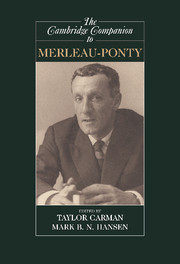Book contents
- Frontmatter
- Introduction
- 1 Merleau-Ponty and the Epistemological Picture
- 2 Sensation, Judgment, and the Phenomenal Field
- 3 Seeing Things in Merleau-Ponty
- 4 Motives, Reasons, and Causes
- 5 Merleau-Ponty and Recent Cognitive Science
- 6 The Silent, Limping Body of Philosophy
- 7 Merleau-Ponty and the Touch of Malebranche
- 8 A Phenomenology of Life
- 9 The Embryology of the (In)visible
- 10 Merleau-Ponty’s Existential Conception of Science
- 11 Between Philosophy and Art
- 12 Understanding the Engaged Philosopher: On Politics, Philosophy, and Art
- 13 Thinking Politics
- References
- Index
3 - Seeing Things in Merleau-Ponty
Published online by Cambridge University Press: 28 May 2006
- Frontmatter
- Introduction
- 1 Merleau-Ponty and the Epistemological Picture
- 2 Sensation, Judgment, and the Phenomenal Field
- 3 Seeing Things in Merleau-Ponty
- 4 Motives, Reasons, and Causes
- 5 Merleau-Ponty and Recent Cognitive Science
- 6 The Silent, Limping Body of Philosophy
- 7 Merleau-Ponty and the Touch of Malebranche
- 8 A Phenomenology of Life
- 9 The Embryology of the (In)visible
- 10 Merleau-Ponty’s Existential Conception of Science
- 11 Between Philosophy and Art
- 12 Understanding the Engaged Philosopher: On Politics, Philosophy, and Art
- 13 Thinking Politics
- References
- Index
Summary
Just as the perceived world endures only through the reflections, shadows, levels, and horizons between things . . . so the works and thought of a philosopher are also made of certain articulations between things said.
Merleau-Ponty.This passage comes from the opening pages of “The Philosopher and His Shadow,” Merleau-Ponty's essay on Edmund Husserl. It proposes a risky interpretive principle. The main feature of this principle is that the seminal aspects of a thinker's work are so close to him that he is incapable of articulating them himself. Nevertheless, these aspects pervade the work; give it its style, its sense, and its direction; and therefore belong to it essentially. As Martin Heidegger writes, in a passage quoted by Merleau-Ponty in the essay, “The greater the work of a thinker – which in no way coincides with the breadth and number of writings – the richer is what is unthought in this work, which means, that which emerges in and through this work as having not yet been thought.” The goal of Merleau-Ponty’s essay, he says, is “to evoke this unthought-of element in Husserl’s thought” (S 202/160).
The risk of such an interpretive strategy is evident. By identifying the essence of a thinker’s work with ideas that he never explicitly endorsed, indeed, by allowing for the possibility that the ideas he did explicitly endorse are in contradiction with the essence of his thought, the interpreter runs the risk of recklessness. Yet there is something to the strategy.
- Type
- Chapter
- Information
- The Cambridge Companion to Merleau-Ponty , pp. 74 - 110Publisher: Cambridge University PressPrint publication year: 2004
- 23
- Cited by



